Split Marathon to Take Place on 27 February
ZAGREB, 20 Feb 2022 - The 22nd edition of Split marathon will take place on 27 February, and about 2,750 runners from 40 countries are expected to participate, organisers said last Wednesday.
"Preparation for the 22nd Split marathon are nearing completion," the president of the marathon's organising committee, Kristijan Sidik, told a press conference.
He said that he was proud that the continuity of the Split marathon hadn't been lost even during these challenging times, which was a rarity in the world.
Split Mayor Ivica Puljak said that the marathon had become an event of strategic importance for the development of the city of Split, calling it a unique sporting and tourism event that promotes all those values which they are known for and which they are proud of.
He said that the City of Split, its services and utility companies would provide their maximum support to make the organisation flawless and to make the competitors coming to the city feel welcome.
"The marketing and tourist potential of the marathon is exceptional, the athletes are also our guests, and in the future we will strengthen the brand of Split as a city of sport and sportspeople even more," said Puljak.
For more, check out our lifestyle section.
Palace of Life, City of Changes Visual Identity Presented: Old Split. New Story.
January 29, 2022 - "The project's visual identity is inspired by lines that represent somewhat chaotic directions of movement, roads, and shortcuts inside Diocletian's Palace, while the slogan highlights a whole new story within the old town." A look at the Palace of Life, City of Changes visual identity.
Palace of Life, City of Changes, is a project in which the Old Town Hall on Split's Pjaca (Narodni trg) was renovated, followed by the renovation of the courtyard and ground floor of the Split City Museum (MGS), which will become accessible to people with disabilities by installing an elevator. Through this project, the southeastern tower of Diocletian's Palace with the Lukačićeva 5 building will be reconstructed and presented to the public, reports the City of Split.
"The project co-financed the renovation and equipping of five buildings, which will provide a unique insight into the invaluable cultural heritage of the historic center of Split and the introduction of new content and presentations of space that have been neglected for years. In addition, the old town hall has been renovated following the latest needs of modern exhibition space. Project documentation is being prepared by Office Vojnović d.o.o. based on which work will soon begin on the above facilities," said Radojka Tomašević, Head of the Service for International and EU Projects, who heads the project implementation team by the City of Split in cooperation with partners - Split Tourist Board and Split City Museum.
Split studio Kazinoti & Komenda designed and created the project's visual identity. Karlo Kazinoti and Mišo Komenda have already been recognized for their quality and memorable design solutions to numerous cultural projects, but this is undoubtedly the most significant Split project they have worked on. The set task resulted in a dynamic identity of pronounced color in which they summed up the directions of movement through the countless streets of Split's historic core:
“The design was created as a reduction of the palace to four squares, i.e., towers, while the walls were completely erased to suggest openness and metaphorically depict life spreading outside the palace. The lines as a formative element are inspired by the somewhat chaotic directions of movement, roads, shortcuts inside the palace created by life within the walls. In the end, we see a similar network of intertwined directions when looking at the sky because of the clothesline (tiramola)," explained Kazinoti & Komenda.
The extended function of this design allows the grid of lines to be applied as a graphic pattern or framed within a given format as needed. The font Spalat by prof. Nikola Đurek and the project's name were accompanied by the slogan "Old Split. New Story."
“The goal was to communicate the novelties in the palace, i..e., the old part of the city, but the specificity is that these 'novelties' are centuries-old heritage, so we drew a parallel between the old and the new. We are erasing the border between them because part of the unknown heritage, which, together with many visitors, will be revived only now and become - new," explained Karlo Kazinoti.
Thanks to investments through the Palace of Life project, the citizens of Split will get a new perspective, the opportunity to enjoy the view of the city from the eastern wall of Diocletian's Palace and from the terrace of the Southeast Tower, which will house the interpretation center and exhibition space. Since its opening, the old town hall has attracted visitors of all generations with an excellent exhibition "Judita 500". At the same time, the Split City Museum on the ground floor and renovated courtyard of the Papalić Palace will receive a new, modernized exhibition that will provide visitors with a completely new experience of old stories.
Palace of Life, City of Changes, is one of the most significant investment projects in the restoration and revitalization of the cultural heritage of Split in more than 60 years, more precisely since the opening of Diocletian's cellars. The project also includes the development of the Old Town Management Plan and the Visitor Management Action Plan. The total estimated value of the project is HRK 25.4 million, of which HRK 18.2 million is a grant from the European Union from the European Regional Development Fund.
For more, check out our dedicated lifestyle section.
Split County Supporting Several Cultural Heritage Preservation Projects
ZAGREB, 24 Jan 2022 - Culture Minister Nina Obuljen Koržinek on Monday held talks with Split-Dalmatia County Prefect Blaženko Boban on cultural projects that the county has prepared for the next multiannual period including the construction of a museum within the fortress on the island of Vis.
Addressing the press after the meeting, which was held in Split, Minister Obuljen Koržinek underscored the construction of a new museum in the fortress on Vis Island, the Salona archaeological site, the Archaeological Museum in Split with its focus being on Salona - and the further exploration and presentation of that ancient locality.
We also discussed the ancient Stećak tombstones and I would like to mention something we discussed ten days ago in cooperation with the Ministry of Agriculture and a new project to finance agriculture on archaeological and protected historical sites, she said.
Split-Dalmatia County has three sites listed on the UNESCO list, the minister said. She added that it is the only county that have as many as three conservation departments, which bears witness to the intensity and wealth of its cultural heritage.
The ministry is aware that no matter how much is invested in preserving this rich heritage, that will not be sufficient. Hence it is necessary to identify priorities and in that regard to further invest in cultural heritage because of its value, the importance for the community and huge potential to attract tourists, the minister said.
Split Census Reveals Reality of Life Under Marjan: Unused Apartments, High Prices
January 23, 2022 - The Split census results revealed that almost every fourth apartment is empty while the prices continue to rise. A closer look at the realities in the city.
According to the new census, Split has 59,947 households and 77,309 apartments, which means that there are 17,362 empty housing units in its area, reports Slobodna Dalmacija.
That is, almost every fourth apartment is empty. If we look at the city without the settlements that administratively belong to it: Žrnovnica, Slatine, Donje Sitno, Gornje Sitno, Kamen, Stobreč, and Srinjine, then Split has 16,069 empty apartments.
This does not mean that all empty flats are also tourist apartments - some owners use them occasionally, and some do not use them at all. But a good flat today is undoubtedly intended for tourism. Several apartments are empty and used only during the season, and prices are multiplying. According to the Central Bureau of Statistics, in the last quarter of 2021, the prices of apartments on the Adriatic were on average 38 percent higher than in 2015.
In parallel with the rise in prices, the number of inhabitants is declining, but empty flats are growing. There were 4,500 in the 2001 census, and only a few years later, at the time of the Split GUP, 6,000 apartments did not have electric meters. Since the last census in 2011, Split has lost more than 16,800 inhabitants and has 17,300 vacant flats. In the meantime, the number of accommodation capacities has increased tremendously.
According to the data of the Split Tourist Board, in 2019, 23,657 beds were registered in households in the city. However, due to COVID, the number of registered accommodation capacities is decreasing, so in 2021 and 2022, the number is the same, and 20,547 of them are registered as household beds.
Housing, on the other hand, is growing. For example, in Mejaši, more precisely around the "Mall of Split" shopping center to the junction with Vukovarska Street, building permits have been issued, or applications for their issuance have been submitted for more than 450 apartments in the last two years.
Although the location and the associated housing conditions could by no means be called elite, this is not an obstacle to the rage in prices. On the contrary, the public was amused and shocked by the ad in which about 4,000 euros per square meter were demanded for a 14-square-meter studio apartment in that neighborhood.
However, children attend the overcrowded Mejaši Elementary School in three shifts. The head of the Split Social Services Department, Mate Omazić, told Slobodna that the City has problems finding a suitable plot of 10,000 square meters to construct a school with a hall in Kila, in the Mejaši district where POS apartments were built.
This example clearly shows why young people are leaving. Namely, affordable apartments are not built, while they are costly in favorable locations and are constructed primarily for tourism or for the temporary stay of those with deeper pockets.
Apartments in poorer locations, which are bought mainly by people in Split today, are too expensive considering what the location offers. Moreover, the environment in which such new buildings are located is poor in infrastructure, greenery, and public facilities. Therefore, the overall impression of such ambiance seems relatively poor compared to the money required to buy real estate, especially when compared to Split in the second half of the 20th century when the city's development was meaningfully planned.
An expert in spatial planning and a member of the Spatial Development Council in the competent ministry, architect, and urban planner Gojko Berlengi predicted in an interview with Slobodna that there would be more than 10,000 vacant apartments in Split in the census. As one of the reasons why apartments under Marjan are expensive and empty, he points out the tax policy, which is not fair to the owners of hotels and other forms of accommodation.
"How many times bigger is New York than Split? And there are only four times as many apartments in private accommodation? They are taking measures to limit the number of flats and require apartment owners to be domicile residents. In our country, the privileged tax on apartments was introduced as a reasonable social measure to help households with a surplus of space and a lack of income. In the end, it turned out that a man came, for example, from Varaždin, and invested in five apartments in Žnjan. He uses a privileged tax, competes with hotel owners, and has a very short season that produces huge peak loads, which the City needs to deal with, from traffic, water, sewage, waste disposal... When entering into a thorough calculation of all negative externalities, cities, and municipalities are thus de facto at a loss," explains Berlengi.
"I am interested in the extent to which the Split Development Strategy and the Agglomeration Strategy, as well as the County Development Plan, will answer such questions. For example, what does one zone with apartments on Žnjan mean to Split? How much tax revenue does the City carry per hectare, and how much does it cost in utility equipment and maintenance? We have vacant apartments and people who have not resolved the housing issue, and at the same time, the city space is being spent on building overpriced real estate. There are public policies that can address this, resulting in these apartments being used for housing and being offered on the market at normal prices, especially if there are more than households. Tax measures and other public policies from the existing fund should activate apartments in the function of housing," Berlengi believes.
Berlengi adds that it is logical that the tax for this activity should be low, but only for people who live on the islands and the coast, where they have one or two apartments. But it is not logical, he says, that as a consequence, it starts to turn into the construction of apartment houses on Žnjan, which are empty for most of the year.
"Half of them are summer apartments, some of a higher standard. When you come, you find the key. You leave it in the mailbox, everything is anonymous, and at the same time, it goes under the lower tax of accommodation in a family household, which should be an incentive for local residents. It is not logical to reward rich people who are not domiciled. Numerous cities worldwide handle things like this, so you can’t rent if you’re not domiciled. In addition, they limit the number of rental days per year and thus stimulate year-round rental. We want to equalize these forms of renting so that the owner does not have the advantage of renting an apartment to tourists compared to year-round rent to families," says Berlengi.
As a result, the number of apartments has doubled since 2012, although the Tourism Strategy foresaw that apartments in Croatia would remain in that number. The infrastructural load in the summer is vast because from Trogir to Omiš, there are 80,000 beds in apartments.
Will the real estate bubble burst? Berlengi believes that valuable real estate is always on price. However, at the other end of the spectrum are numerous lower-quality properties on the city's outskirts that could be a problem.
"Anyone who has invested money in them at one point may have difficulty cashing in if, of course, there is not as much demand for housing due to fewer residents and households. Dwellings have become a commodity that preserves the value of the property. However, it is like a financial pyramid, and any such pyramid eventually collapses. I don't see how this could survive in the long run if you don't live in those apartments and if a normal real estate tax is introduced, so unused real estate becomes an expense. But our state is slow, and perhaps the problem is that those who decide on it have too much real estate themselves. For now, the state de facto supports the rentier mentality. It sterilizes financial capital for productive investments by buying unnecessary real estate; for example, we have thousands of hectares of uncultivated land, and we import billions of euros of food," adds Berlengi.
"Split has increased the number of apartments by five to six times. There are almost 10,000 apartments in Split, about 8,000 in Vienna, about 50,000 in Paris, and about 40,000 in New York. I see this as the primary form of pressure on coastal settlements and space, but also on the affordability of housing because apartments are becoming too expensive, which with already negative demographic trends is driving local people out of cities," concludes Gojko Berlengi.
For more, check out our dedicated lifestyle section.
From Diocletian's Palace to Poljud, Split Tourist Board Presents 360-degree Split Virtual Tour
January 20, 2022 - The Split Tourist Board has presented a 360-degree Split virtual tour on Wednesday, allowing those near and far to explore the city's top attractions.
The Split Tourist Board has announced a new virtual tour that presents Split through a modern and interactive visual display. The project was realized in cooperation with the L33T digital marketing agency, and the City of Split, Split museums and other cultural institutions in Split participated in the project.
"These are 188 virtual panoramas, produced from 17,600 photos taken from the air and the ground so that they ultimately have a resolution of more than 230 MP (megapixels) which allows the visitor to enlarge content and view every detail of the scene. On the other hand, the HDR production technique guarantees a crystal clear image and a huge amount of detail. The virtual walk also contains interesting short texts in Croatian and English, which additionally attract visitors and inform them about the main locations," explained the Split Tourist Board.
They add that virtual walks are made in HTML5 technology that works on all platforms and devices without any application installation and the like, but directly through a web browser.
"The time of the pandemic further strengthened the importance of applying technology in the promotion of the destination, so with this project, we wanted to bring all potential tourists even closer to the beauties of Split to choose our city for their long-awaited vacation, but also to present it to those currently unable to come to Split. This is one of our projects by which we follow the world trends in destination marketing management, and we believe that it will contribute to the realization of a successful tourist year," said Alijana Vukšić, director of the Split Tourist Board.
You can enjoy a virtual walk through sunny Split and explore the beautiful details of Diocletian's Palace and more at 360.visitsplit.com.
Source: Dalmatinski Portal
For more, make sure to check out our dedicated travel section.
Split Winter Tourism at Chops Grill: Chopsylicious Menu, Weekend Music, Christmas Flair
November 15, 2021 - Is Split winter tourism that hard to achieve? Croatia's second-largest city and the star of summer loses its buzz as soon as the seasons change. But it doesn't have to be that way. Our new TCN series looks at the Split businesses working hard in winter to give locals, and visitors, the environment they deserve. Continuing this week with Split winter tourism at Chops Grill.
I was lucky to be introduced to Jasmina, the owner of Chops Grill, in my early days with TCN. That is something I am grateful for to this day. Not only is Chops one of Split's best restaurants, maintaining quality and culinary consistency year-round, but Jasmina and I have built a wonderful relationship over the years - and she continues to inspire me season after season.
Chops Grill is not your typical Split restaurant, but a superb steakhouse that rewards guests with the best cuts of meat, American influences, and, of course, a Dalmatian touch. Jasmina and Chops also know no season and are applauded for working tirelessly year-round, adapting their offer depending on the time of year, from unique 3-course menus to on-the-go breakfast sandwiches.
But what motivates Jasmina, Chops, and sister cafe bar Paradiso to bring the best to guests even in the winter?
Croatia and Split had booming year-round tourism in the 1980s until the outbreak of the Homeland War, but now the Dalmatian coast sleeps through the winter. Why do you think that is?
First of all, I think we were a more affordable destination at that time. I know this because when I worked for Sunčani Hvar back in 2006, we had half-board offers that were very cheap per person through agencies.
There also aren't as many big tour operators today. Everything is done online. Tourists do their own research and don't need agencies or operators as much.
And because nothing is state-owned, the prices are much higher, even in the winter.
Back in the 1980s, many hotels offered health tourism, spas, and indoor pools, allowing older travelers to visit here even when the weather wasn't as nice. Today, we mainly have city hotels that do not have spas or facilities to accommodate winter tourism.
If flights were not the problem, does Split have a winter tourism offer, and if yes, what is it?
I feel bad for tourists that visit Split in the winter, especially now. The only real options are for visitors to have dinner then drinks in a half-empty bar. Guests ask us what they should do after dinner, and we honestly don't know what to tell them.
The museums here are great and interesting for Croatian schoolkids needing to learn about the history of Croatia, but for international tourists, and even if I was a tourist here, there are no interactive museums where you could spend the day. When it comes to culture, we are also lacking in offering shows. HNK is amazing, but the program is mainly in Croatian, which doesn't tempt tourists - especially when musicals or drama plays are in focus.

If I am on a city-break getaway with my husband, I would also want to go shopping, which is a huge problem here. My guests often ask where they can buy certain designer items. The people that come here are minimum middle to upper-class guests. They pay big money for their hotel room - around 300-400 euros. Most people on city-break trips travel without their kids - usually with their significant other or friends. This then targets travelers who want to go to a nice show, dinner, enjoy good cocktails, and maybe explore a museum. But they will also want to go shopping, and there isn't a designer shopping offer in Split. This is a problem we need to start addressing now. The wealthy Russian tourist cannot buy their Chanel in Split but can elsewhere. They could go to Montenegro instead.
Istria already has a winter tourism offer, but Inland Dalmatia is not yet as developed. If you're coming to Split for 3-4 days, wouldn't you want to spend one day in nature with a local family that will serve you their homemade wines and products? Especially somewhere that is only a taxi ride away from Split? There are few places you can send tourists for that experience, and we see a lot of interest around this idea from our guests at Chops. We already have beautiful villas with pools in Imotski, but a nice family farm or winery where you can spend the day? Our current offer mainly targets Croatian families for a Sunday lunch. It's not a Michelin-star experience, but it's an authentic and local experience, and tourists would love it, too.
Are you aware of any initiatives to improve the winter tourism situation?
Only Paul and Total Croatia News, haha. I've been part of the tourism industry for a long time, and I don't know of anything happening at the moment. Oh, but I do know that the Mall of Split bus is running from the ferry port!
Give us a few quick wins that could make Split a bit more attractive in the winter months?
Shopping, winery day trips from Split, contemporary/interactive art and museums, and shows. This is what I believe is most important for Split to offer in the winter. There also are not many destinations that offer both the beach and city-break getaways. Maybe Nice and Cannes if we are talking about cities comparable to Split. But what do they have? Shopping, art, and beautiful restaurants - but why? Because they have yachts. They have a similar climate, but it is not swimmable in the winter there either. Yacht owners, however, keep their yachts there in the winter. They check up on them and maintain them in the offseason. They know that bars and restaurants are open and that they can shop. Montenegro is starting to do the same thing. We have a lot of regular guests at Chops that live abroad but keep their yachts here in the winter, but what can we offer them? We also have an advantage compared to similar cities because these guests can easily fly into Split Airport, check on their yacht, and spend 2-3 days in Split. We need this tourism.
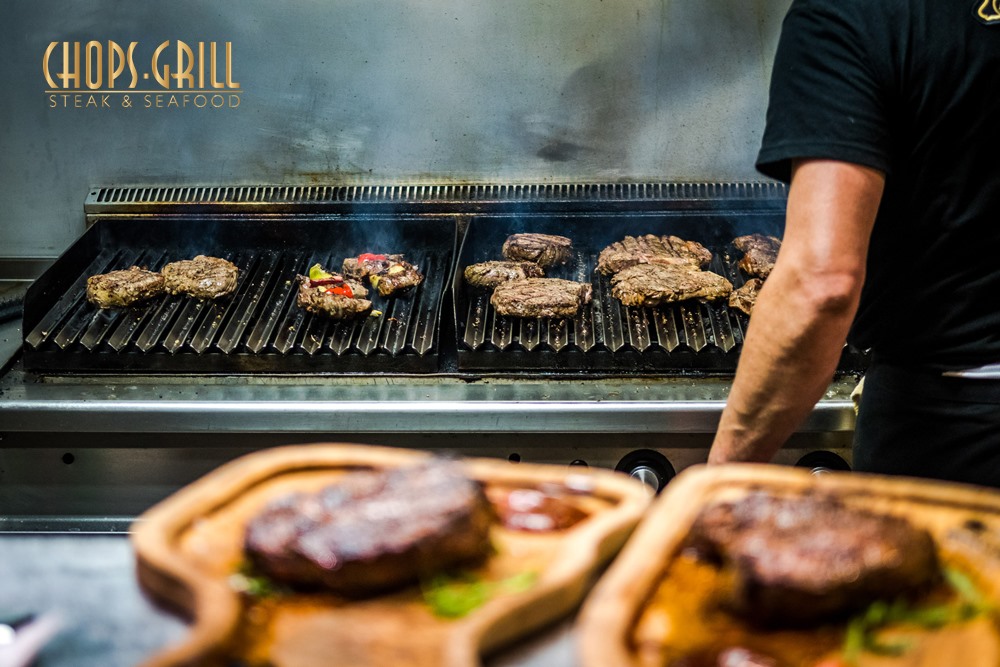
Are you planning an event(s) of your own soon?
On Saturday night we had a lot of reservations, due mainly to our Chopsylicious menu, which we have been doing for the last 7 years! Once we announced it this year, the interest was crazy. Everybody wants to try the menu, which is an excellent value for money. Diners can taste some of our products during the winter when they have more time. We have adjusted the menu to the season. For example, we are not selling the wagyu for 200 kuna. Instead, we changed the menu and are using it to test new dishes for next year. We are tracking what guests like and improving what is needed. When next season comes, we can introduce it to our menu. It's a win-win situation. And guests who like the Chopsylicious menu revisit us in the summer or recommend us to friends and family!
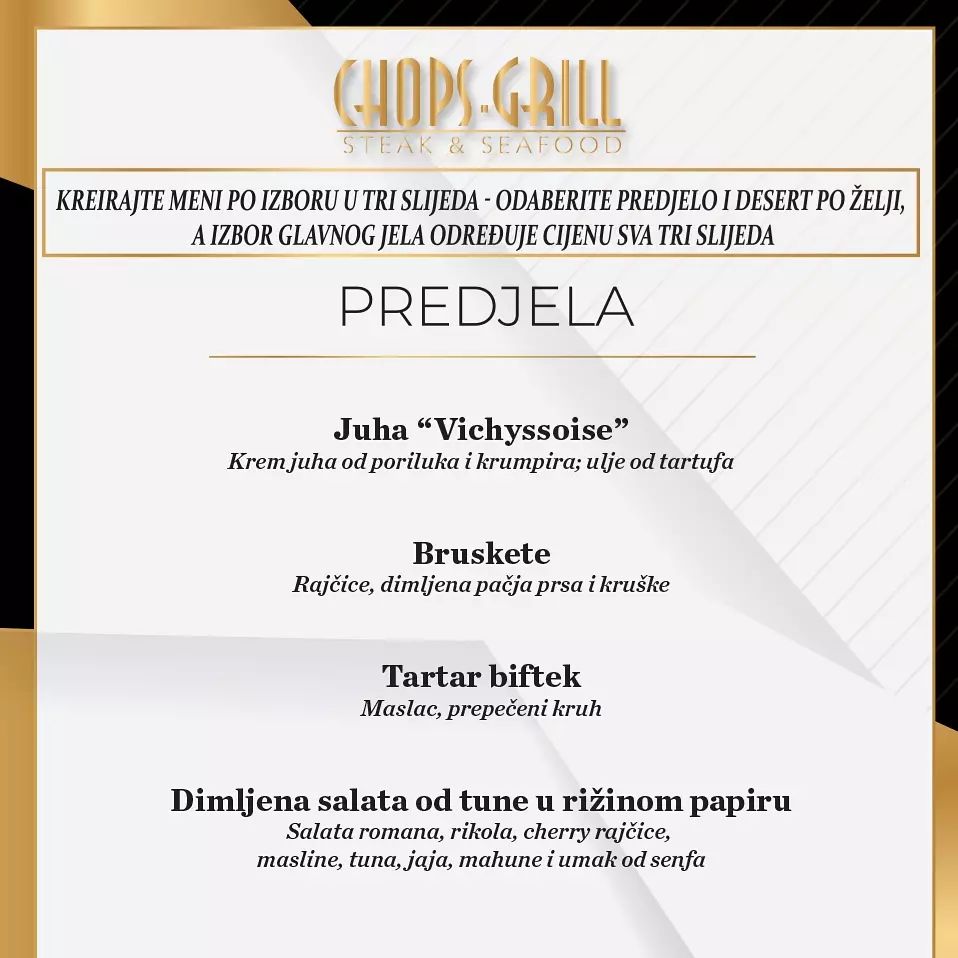
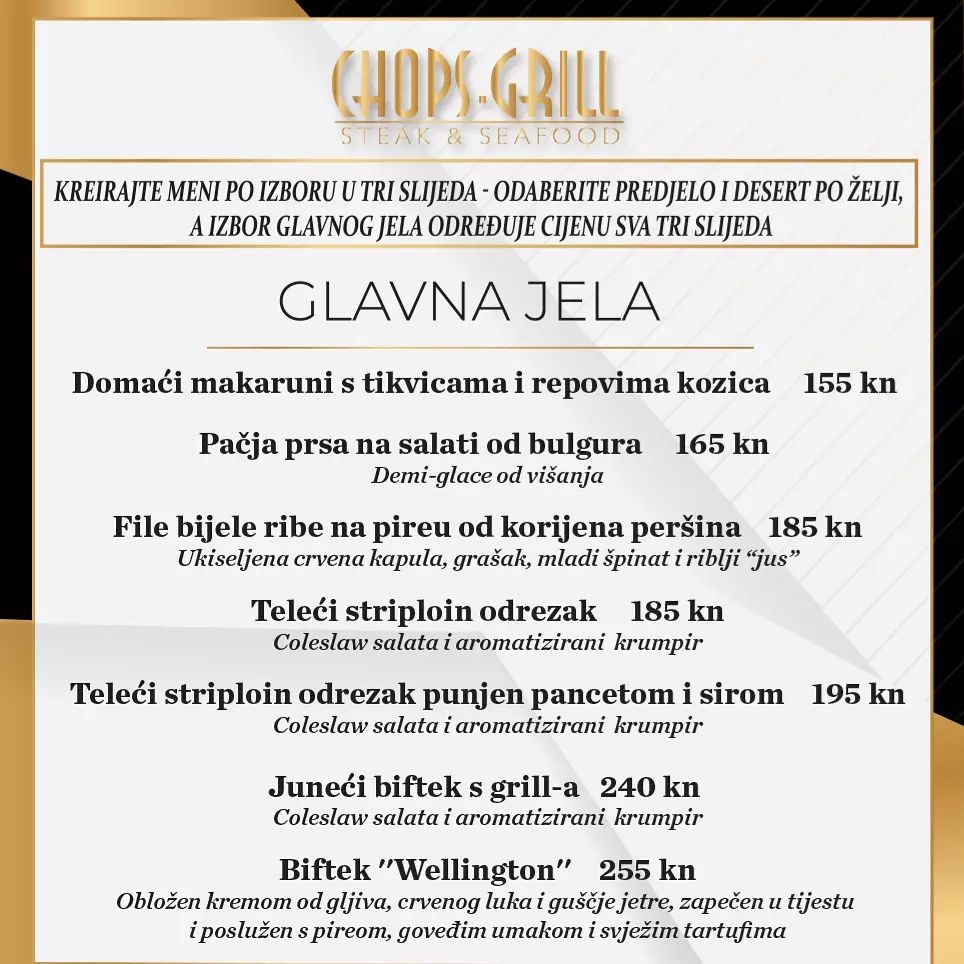
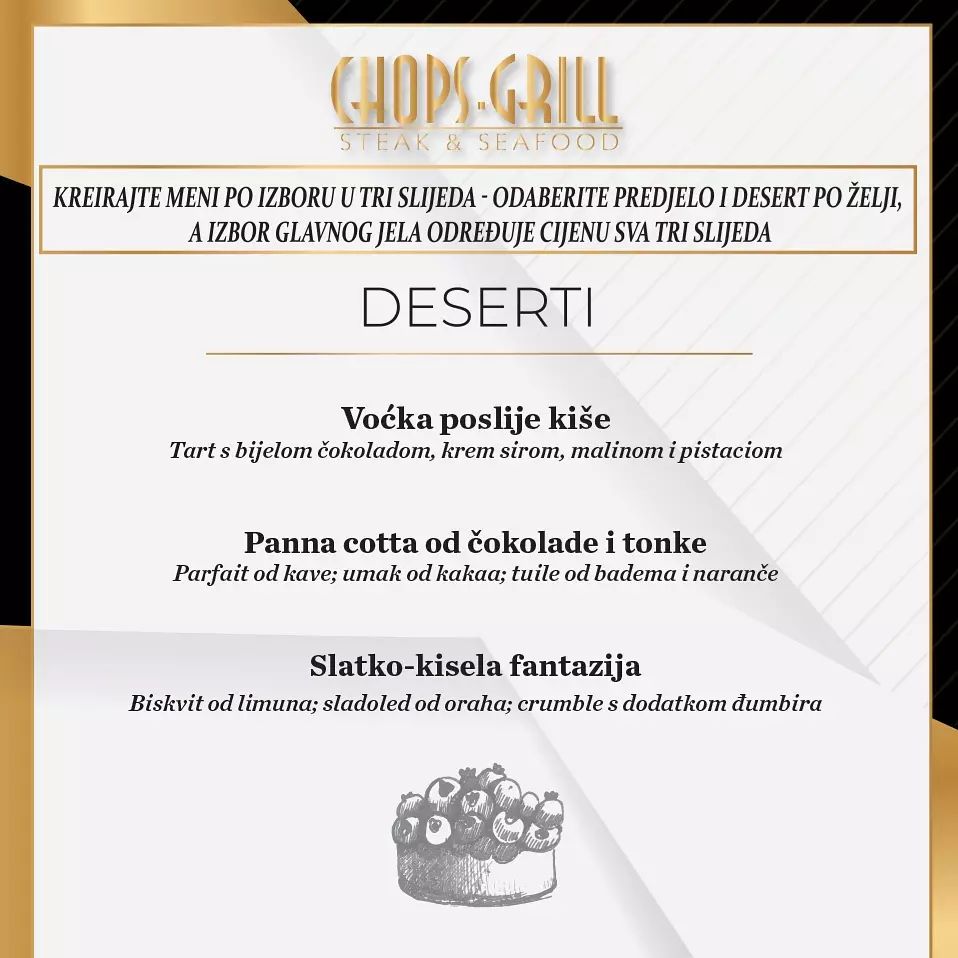
Besides Chopsylicious, we host two music professors from the Josip Hatze school who play inside the restaurant every weekend. Paradiso will be bringing in some light live music from next weekend, and we will begin decorating for Christmas as part of our winter wonderland. We have done it already for two years, and it's beautiful. This year we are going the extra mile to create a Christmas village. We will once again offer our breakfast sandwiches at Chops and Paradiso, so people will always have a place to eat and drink.
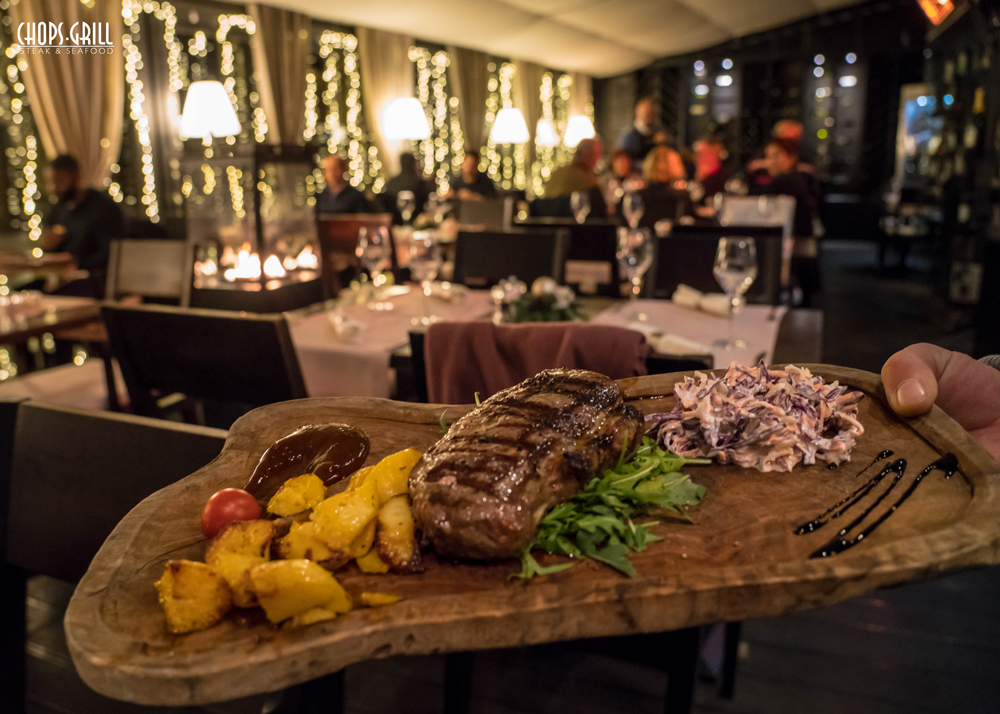
Will you close at all this year?
We always close from January 6 to March 1. It gives us a small break, but we also need to use the time to prepare for the season with renovations. We cannot preserve everything and need to repaint, repair the chairs, and the like. We also use this time to create the menu.
Back in 2020, we had plans to keep Chops open year-round. But, of course, the pandemic happened instead. That remains our ultimate goal, and I don't think we would have much trouble doing business even in January and February.
When winter tourism is mentioned, many locals say that they do not want it, as they are tired after the busy season. What is your perspective as a successful business owner?
We want it! We do need a break; everyone needs a break. I know I do because I have never worked harder on the operational side of things than this summer. But I only need about 15 days. I get nervous after that, haha. I need to do something actively; I cannot just twiddle my thumbs at home and not work because we had a 'successful season'. The Chopsylicious menu and our winter offer keep us busy, and I am happy we have that.
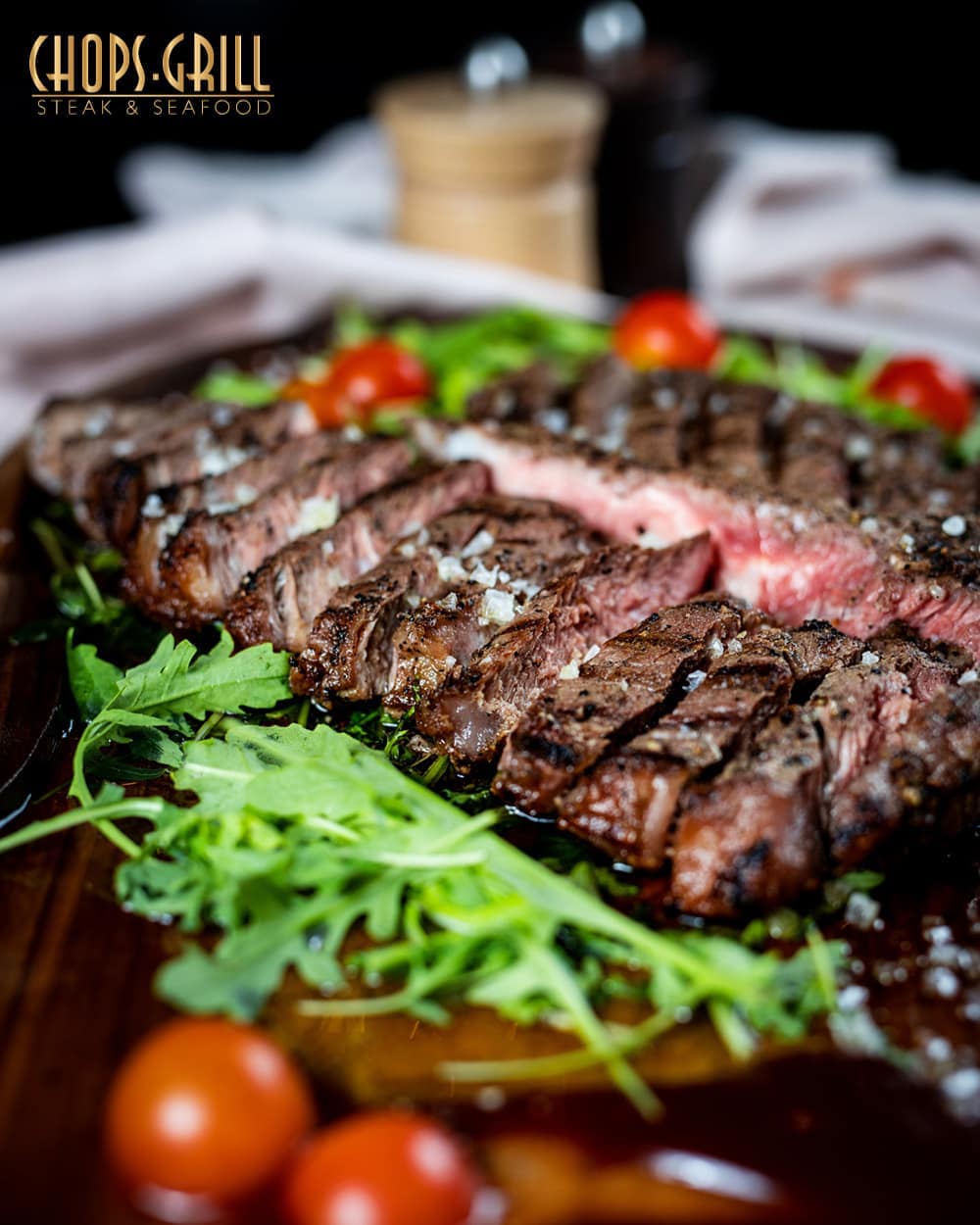
I would be terrified to close my doors for the entire winter. You cannot keep quality by doing that. Businesses that close in the winter also make the hospitality industry less desirable. It makes us a servant to our tourists. If you can work for an entire year, especially at a restaurant with a lot of business in the summer, and have good business throughout the winter with a year-round salary, then being a waiter is a beautiful job where you can support your family. Who wants to be a waiter only for 4 months? Then it's just a student job.
We care about our suppliers a lot and try to find a lower-cost product in the winter than the premium products we offer in the summer. With our chefs and their innovation, we create affordable dishes that guests can enjoy in the offseason. For example, the tuna salad on the Chopsylicious menu uses lower-cost ingredients but looks beautiful. The most expensive part of that dish is that someone had to come up with it in their head. If I am looking at that as the owner, the cost of that dish is lower, but someone needs to think about how to create that using the products available. That is why I invest in my staff throughout the year, and that is how you can adapt your offer in the winter to make sense for your restaurant and your guests.
What are the key steps in your opinion to getting more flights in winter? (Optional)
The Marriott (which will open eventually), Le Meridien Lav, Radisson Blu, and Atrium offer over 1,000 hotel rooms combined. All of those hotels have a spa, which I've already mentioned is crucial for city-break destinations. That's about 2,000 potential guests per day, offered beautiful hotels, great service and food, and indoor pools. If they all got together and spoke to a low-cost carrier about offering and filling these 1,000 rooms, that's a solution. It could almost be some non-formal tour operator. Say, for example, you buy the flight from a low-cost carrier and are offered reasonable rates at these hotels. This is especially important on the weekends when there are no business people from Zagreb in Split. But I truly believe these hotels with indoor pools need to come together; that is the only way it will work. Think - 2,000 people per day is 14,000 potential tourists per week. Those guests will be able to visit the hotel spa and swim, have a nice dinner in town, go to a cocktail bar, and even go to Joker for shopping!
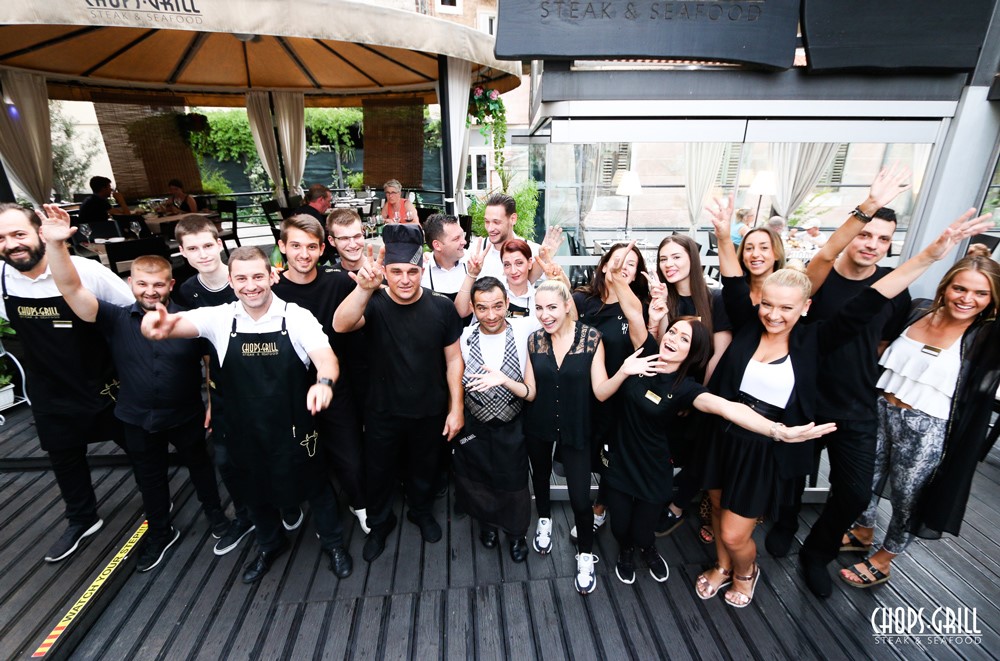
I would also try to create a promo video for tourists showing them exactly how their 4 days in Split would look, instead of just sharing Croatia's most beautiful destinations from above, usually without people. You could create a beautiful 'day-in-the-life' type of promo video showing exactly what you can expect on your Split trip. We need to show tourists what they can do here and not just share aerial footage.
Message to other businesses in Split?
If you stay open in winter, the summer will be easier since you can keep your staff. You'll offer better service, too. If you have both of those things, you'll earn even more money. And if we are all open during the winter, buying from our suppliers won't be as complicated!
Some businesses see each other as competition. If you have a city with many good restaurants, people visit for gastronomy, meaning they'll choose a new restaurant every day. Having more quality restaurants means more business for everyone. This would also help us to be recognized as an excellent gastronomic destination. We all need to support each other. Why can't other restaurants recreate the Chopsylicious idea? That is a wonderful idea, and it gives us more places to visit for dinner!
We also need to think about the minds of tourists and understand that they may not want to eat Dalmatian food every day of their trip. While local food should be enjoyed, it is impossible to expect that someone will eat grilled fish and blitva all the time. I know that when I am visiting Mexico, I cannot eat Mexican food every day. Sometimes you need a burger or pizza; comfort food that hits the spot and gives you a taste of home. And that is fine, too.
We offer eggs benedict on our breakfast menu and make the English muffins in-house because you cannot find them in Croatia. While we have to put in more work, knowing that our guests have that piece of familiarity is worth it. We also can't expect that every tourist likes eating fish or can peel scampi! A lot of these experiences may be new to them. That's why we should think about what tourists have available at home and try to recreate it in our way with traditional influences.
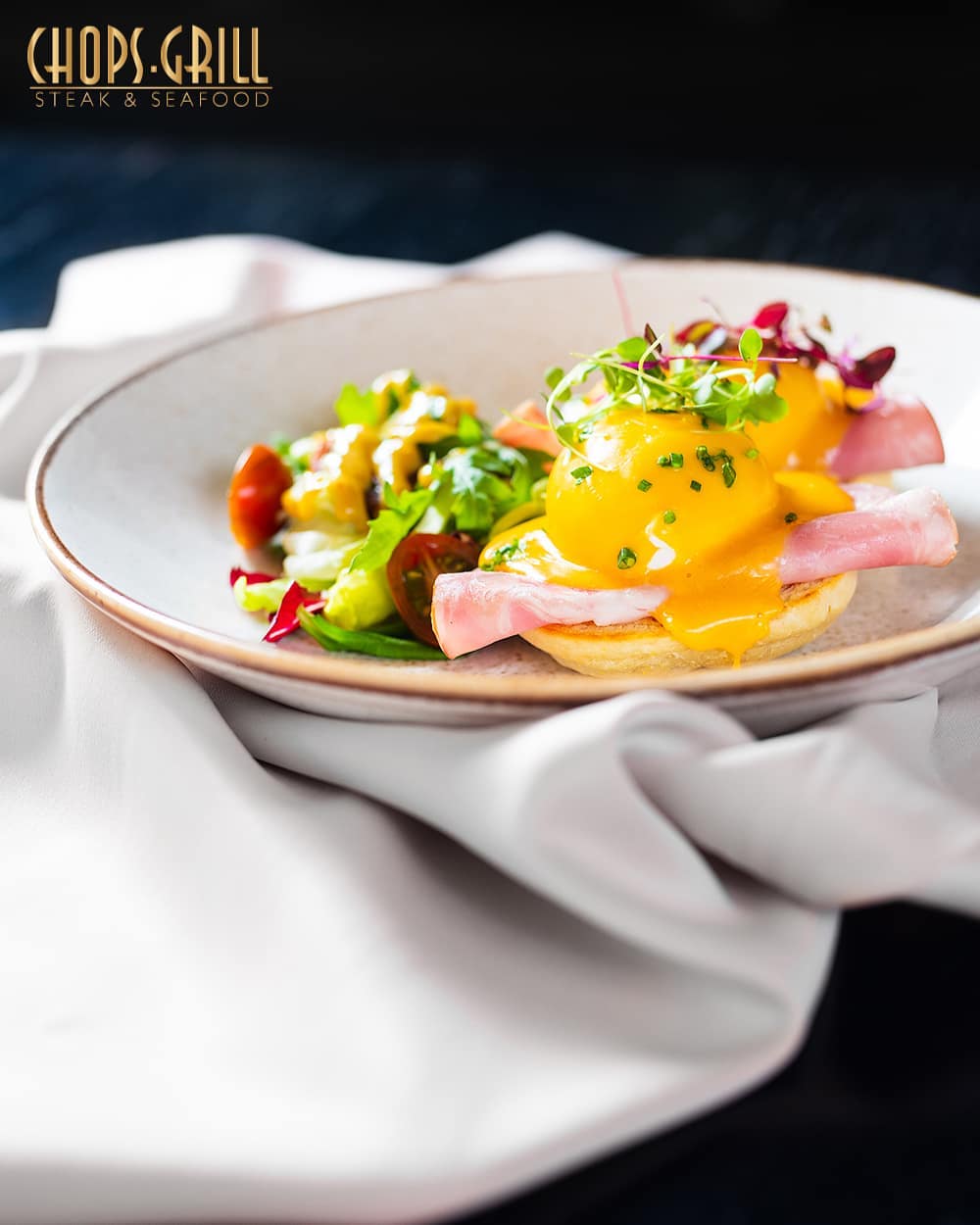
This is the direction we need to be going in. We should never lose our identity, but let's celebrate international cuisine with a Dalmatian twist.
You can explore Chops HERE.
If you are a business in Split with a winter program, please contact This email address is being protected from spambots. You need JavaScript enabled to view it. with the subject Split Winter Tourism.
Split Winter Tourism: The Daltonist Presents Chef Takeovers, Live Music, Art Exhibits
November 10, 2021 - Is Split winter tourism that hard to achieve? Croatia's second-largest city and the star of summer loses its buzz as soon as the seasons change. But it doesn't have to be that way. Our new TCN series looks at the Split businesses working hard in winter to give locals, and visitors, the environment they deserve. First up, meet The Daltonist.
I'll never forget being congratulated after making it through my first Split winter as if I was nuts to attempt such a feat.
"How did you survive?"
"How could you enjoy it after living in California and London?"
"Isn't winter in Split too boring for you?"
But the reality of my first winter in Split is wildly different. It's the reason I decided to stay in Croatia at all. Sure, it pales in comparison to the bustling summer months, but thanks to its mild climate and sunshine, I'm still wearing sunglasses here year-round. And if you can get through that one bad month of brutal bura, I promise the weather will reward you the rest of the year.
Split winters, however, are not nearly used to their full potential. Instead, they are reserved for the locals to hibernate after a busy summer, with 50% of restaurants, bars, and businesses saying goodnight after a season well done. The once-lively old town becomes a ghost town, with the few flickering lights of restaurants and cafes reminding us they're still there should we wish to visit them. And those same businesses endeavor year after year, hopeful that this offseason will be the one to bring life back to Split. TCN is shining the spotlight on them in our latest series.
First up, we meet owner Luke Stewart and marketing & brand director Flor Vignaroli of The Daltonist, a craft cocktail bar and gastropub around the corner from Pazar and just outside the palace walls.
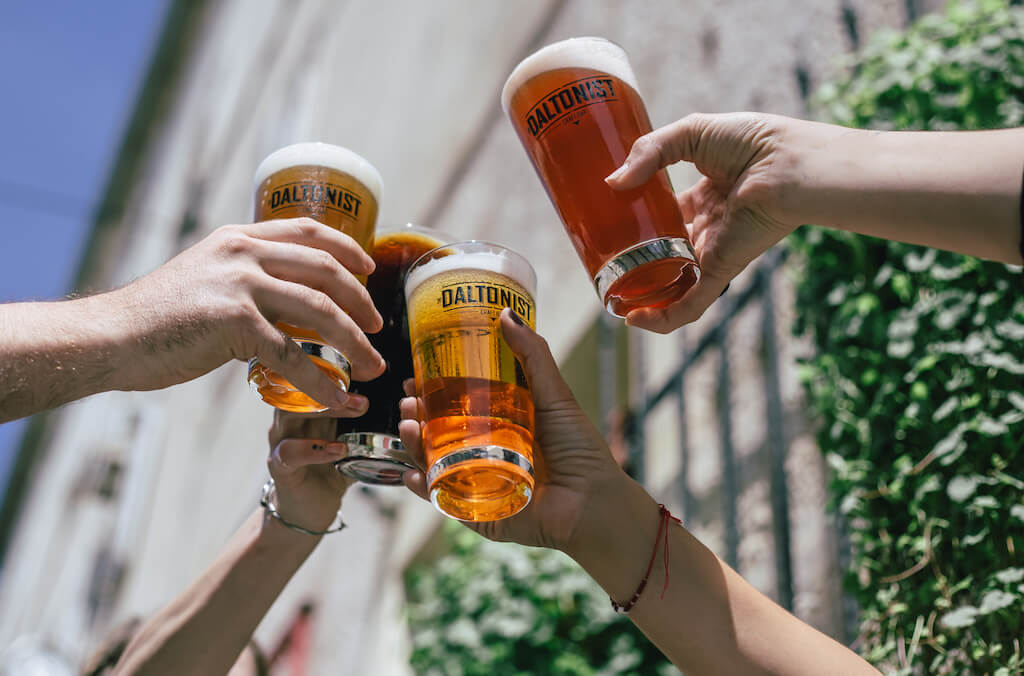
Croatia and Split had successful year-round tourism in the 1980s until the outbreak of the Homeland War, but now the Dalmatian coast sleeps through the winter. Why do you think that is?
Luke Stewart: I think a lot of it is cultural. I think now, compared to the 80s, there is much harder work in the summer. The summers are crazy and tiring. So you combine this culture of people not wanting to work so much with people having to work twice as hard in the summer, and I get it. Dalmatians love the sun. When the weather isn't good, it sucks the life out of all Dalmatian people, and I think that is also a big part.
There is also no awareness. No one is doing anything to bring people. Just like Paul (Bradbury) said, if there are no flights, how will people come?
If flights were not the problem, does Split have a winter tourism offer, and if yes, what is it?
Luke Stewart: It's kind of like the chicken and the egg. If people were coming, people would do something, and at the same, if people were doing something, they would be more likely to come. Zagreb Advent started for locals, and it was very much a local event. Based on that example, you have to do something for people to start coming. But how do you do it?
Locals don't go out as much or spend as much money. So if you are trying to provide an offer that international people will come for, that needs to work locally in the beginning. If locals don't want it, it's a catch 22.
Being from Leeds, do you think tourists from the UK would visit Split in the winter?
Luke Stewart: I think they could, but right now? No way. It is very much seen as a summer place because it is exactly that. If you google Croatia, you see beaches, beach clubs, the sun, boats, and the like. So why would people want to come here in the winter? Prague and Brussels are places people want to go to in the winter because they are cozy and festive. Zagreb did a great job at that, too. But the coast? No way.
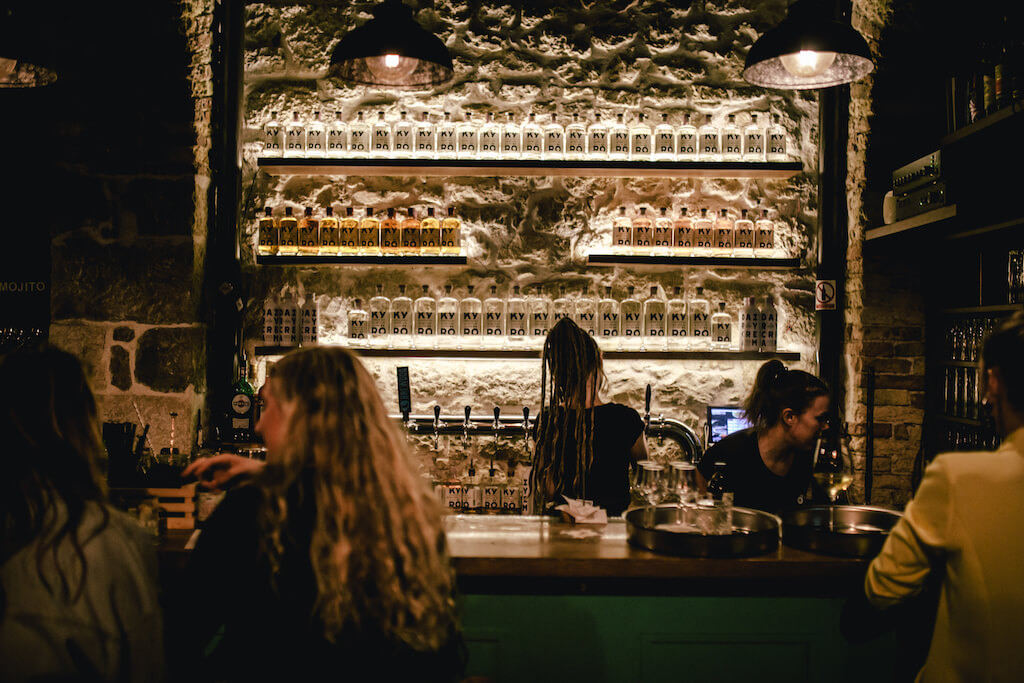
Are you aware of any initiatives to improve winter tourism in Split?
Luke Stewart: I've been following what Total Croatia News has done around the subject, but in terms of tourism, not so much. In terms of winter hospitality, many of us are trying hard, and we do every year. Many really good places stay open all year, and there are a lot of places that only open in the winter that are essentially unheard of to foreigners - and they are amazing.
What would help develop things? If the city remembered that local hospitality is just as important as tourism. Everyone that stays open all year has this idea that tourism comes second - and it will come. But if you focus just on summer tourism, you lose the local vibe, which is something people would actually come for in the winter.
Give us a few quick wins that could make Split a bit more attractive in the winter months?
Flor Vignaroli: I am from a big city - Buenos Aires. The winter is the same as the summer - or even better. In the summer, everyone goes on holiday, and during the winter, you have an endless list of things to do. Of course, things have changed with the pandemic, but you have live music, art exhibitions, museums, and street events. The Riva is an excellent location to host events during the winter. It shouldn't just be a place where locals have coffee. The City needs to offer more to the people that live here. Whether they are paid or free events, it doesn't matter. In general, there is not much going on. Look at the Koteks building, for example. It just sits there. What an amazing location to host an event!
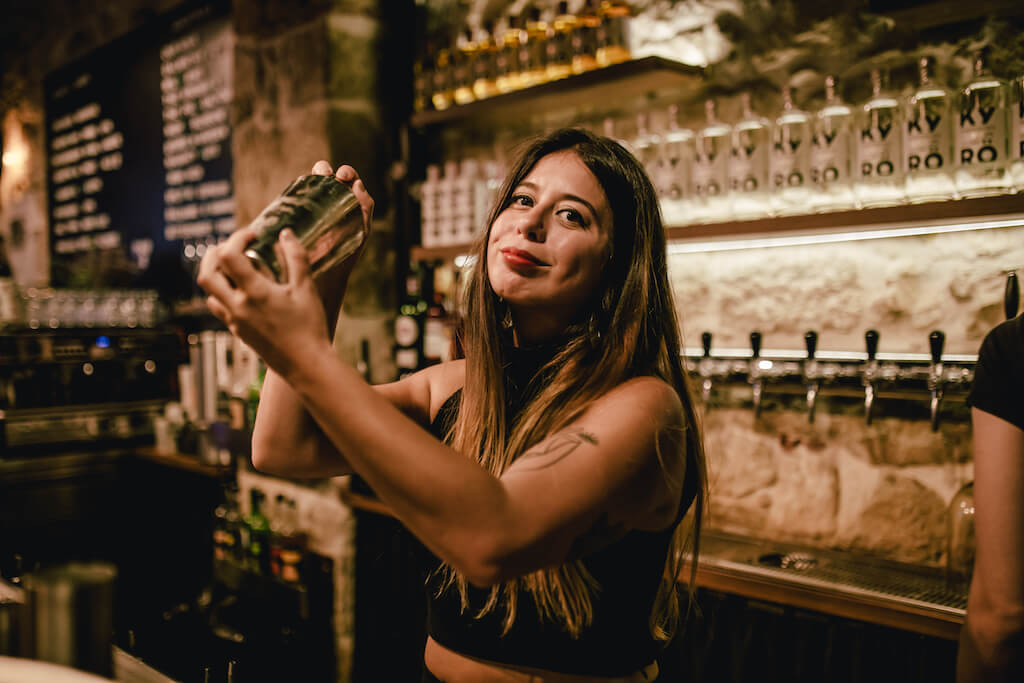
Luke Stewart: Dalmatia forgets that we are our own country; we are not just a holiday resort. You can't compare Dalmatia with the rest of Croatia as it is totally different. And it is almost like the mentality has shifted - that we are one giant holiday resort, that is what we are good at, and this idea of being a living and breathing city goes down every year. If that were fixed, that would be the change. People go to Prague or New York in the winter because of the buzzing local life - even when it's -10 degrees. The winters should not be about what we can do for tourists but what can we do as a city? If the city is alive and exciting, the tourists will come. Do you want to go on holiday to a city that's closed? It doesn't have to be waiting for you to arrive like in summer. But imagine going to a bar in Split for your first time, and it's December, and it's packed full of local people.
Flor Vignaroli: When you're traveling, you want to see the local scene. Is there even a local scene in Split at the moment? You work hard for 4 months during the season, really hard, then you have nothing to do in the city you live in when you can finally relax. We want to provide locals with something to do. Otherwise, it's boring. We don't only work for tourists. We always make sure our prices are fair for locals. We have a big selection of quality beers that range in price. We try to serve the local population.
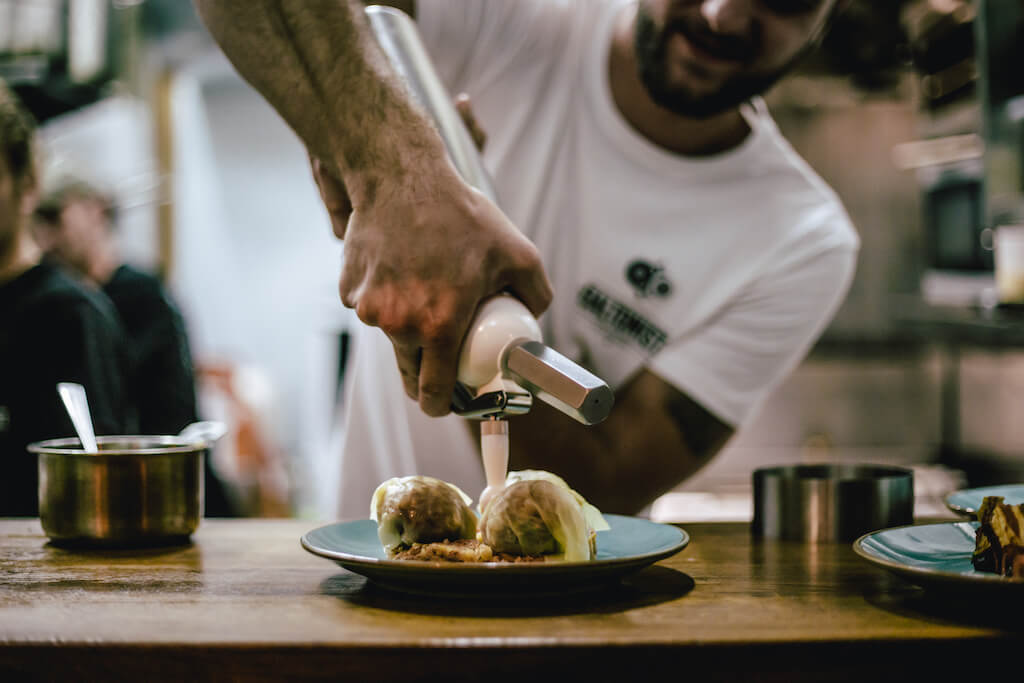
Luke Stewart: We also don't bump our prices up in the summer. We sell a more premium product in the summer with a more premium experience. Our winter is cheaper not just because we are dropping prices and margins, but we are offering something simpler. We can serve eggs benedict in summer with shaved truffles for 100 kuna, but we aren't selling the same thing for 60 kuna in the winter. We have a different version that works out to be less for local people.
And what about the winter events at The Daltonist this year?
Flor Vignaroli: We are starting with live music, DJs on Fridays and Saturdays, and are working on doing different kinds of events, for example, a chef takeover with Mate Janković. We chose Mate to launch this new event series at The Daltonist. He will create a 5-course meal paired with Croatian Varionica beer. We are selling tickets in advance to make sure we can control the Covid measures. Our idea is to offer people something different. We want to provide events we would want to attend ourselves. Things are happening in other cities, but why can't we do that while supporting local artists at the same time? We want to showcase people from Split and foreigners. We want to host an art exhibition with Luka Duplančić at the end of November, and will continue with events in December. We also hosted a gin masterclass last month and did a bar takeover in Zagreb a few weeks ago, and we plan on doing the same in Split.
Someone suggested we do an open mic night, so we are discussing that idea right now. We want to offer something different every day of the week. We have the space for it, so why not?
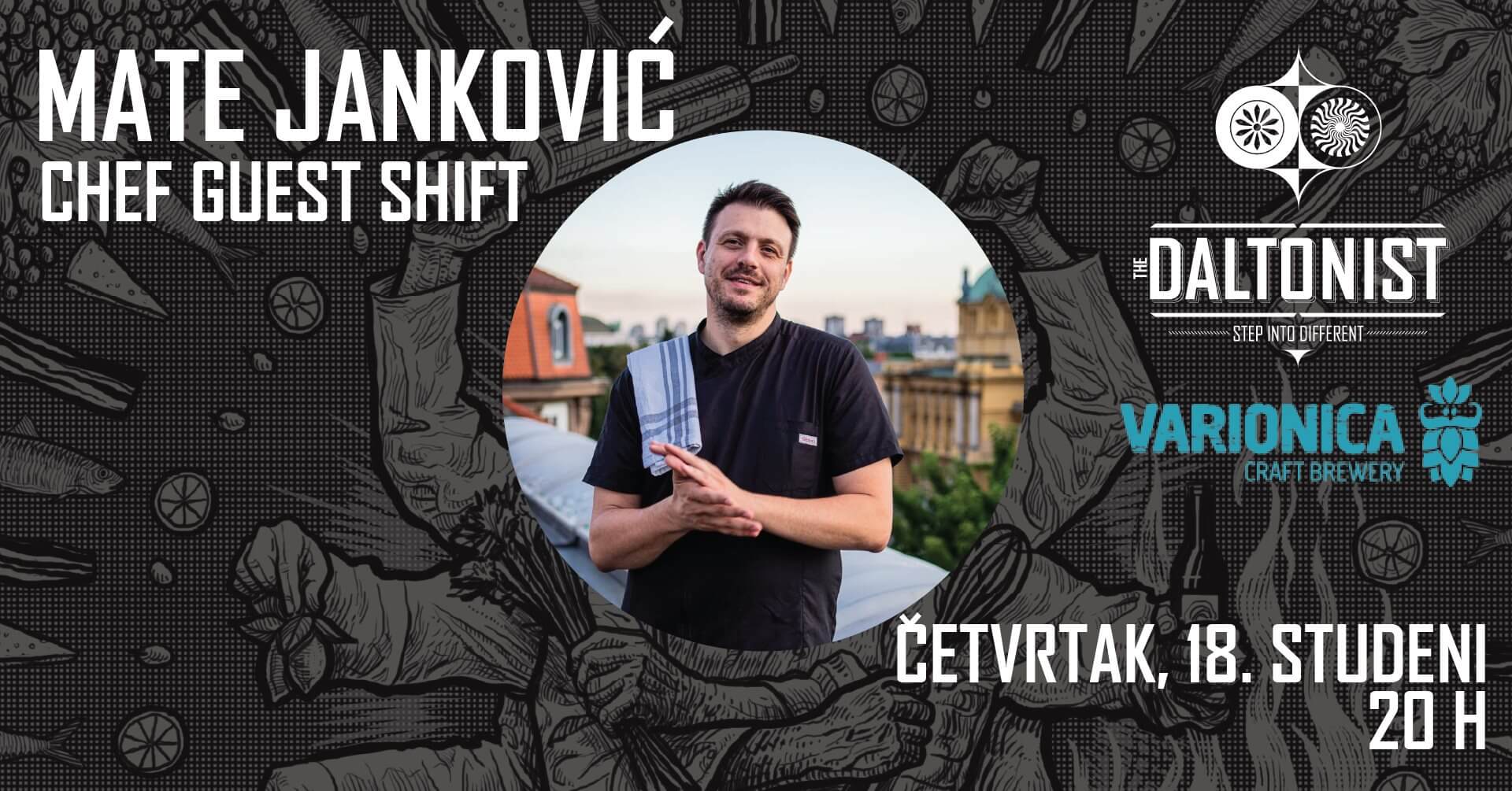
Luke Stewart: Our goal this winter is to focus on community-based events. And mainly to have fun. You work your ass off in the summer. Hospitality is a fun job, and we all work in this because we don't want that boring 9-5. We have friends all over the country doing the same thing. So now, in the winter, we get to create events that are fun for us while giving back to the local community.
For example, our neighbor has the best coffee in Split (Soul Coffee). He attracts the morning crowd while we draw the evening crowd. But in the winter, it is too cold for him to work. We have zero interest in selling coffee, but because we have a good relationship, and his coffee is great, we are selling it at The Daltonist this winter. That way, his local customers get the Soul Coffee experience year-round, and we get to sell great specialty coffee. It's a win-win for everyone.
Winter is just as enjoyable for us as the summer. We don't plan on closing at all, apart from New Year's Day, as we are all too hungover to work. This winter will undoubtedly bring more challenges, especially since we killed smoking. But we really believe in it and aren't trying to stay open to make crazy money.
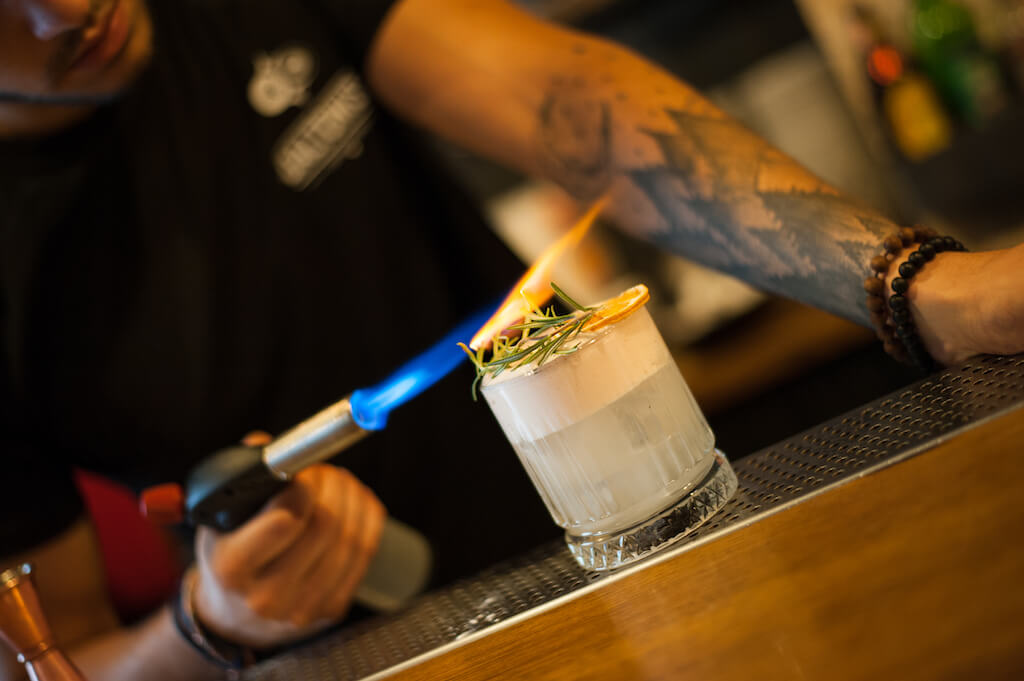
In the middle of the interview, an inspector visited The Daltonist telling them they had to take down the decorative plants hanging on the outside wall as someone had reported it.
Luke Stewart: That would really help winter tourism. On a national, regional, and city level, the government is constantly trying to suffocate and choke the people who are trying to make things happen. People try to do nice things here, and then the inspector comes and tries to punish you for it. You're often driven to the point of wondering why you're even trying. It's really draining.
In general, small businesses are enemies of the state. But small businesses drive community and culture. And that is what we bring people in the winter. If a business is allowed to thrive, it is good for the local and travel economies.
Flor Vignaroli: Digital nomads, for example, want a nice co-working space and apartment, but when they close their laptop, they want to have fun. And where will they go if the city is dead? So that is a massive point of why we are doing what we are doing. For the local community and for the people wanting to live here.
How has your clientele shifted moving from summer to winter?
Luke Stewart: We are still seeing a lot of foreigners, but we are also seeing people staying here long-term, from digital nomads to people escaping Covid at home. We noticed a lot more long-term visitors in the summer as well, whether it is for one month or three months. The digital nomad movement has been a huge part of that. So while there may be fewer tourists, it feels like a lot of foreigners are still here.
The local crowd also comes back out in the winter. You don't see any locals in the summer because they're either working or staying away from Split. October is the month where we see the shift. We like it best when it's 50/50 - half locals, half foreigners. That's when we feel most like an international bar. And that's what winter tourism is about.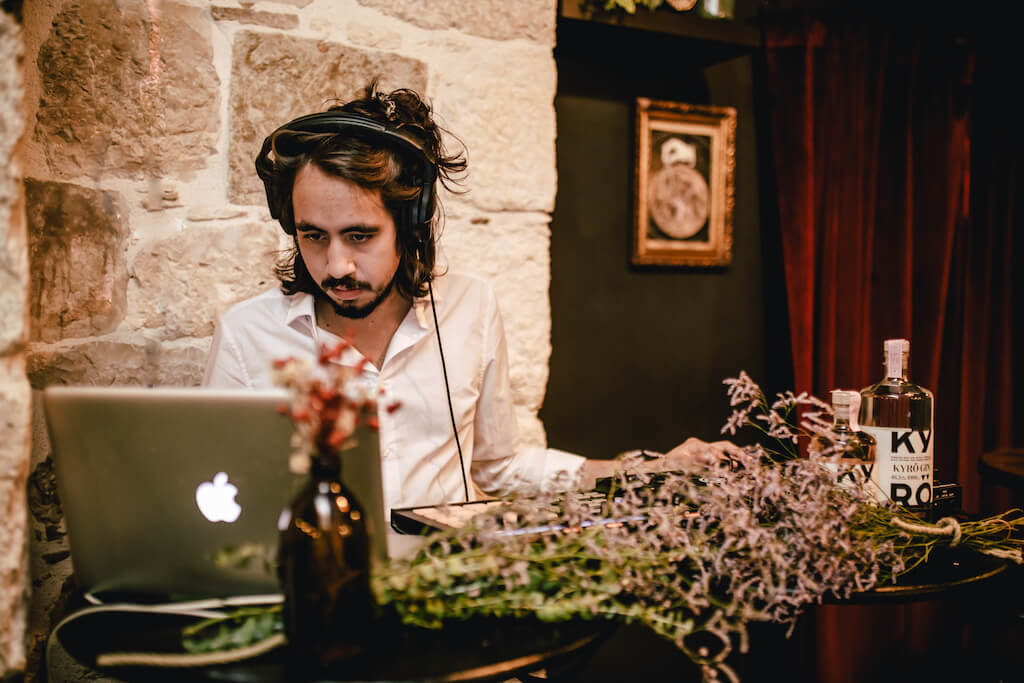 What are the critical steps to getting more flights in winter?
What are the critical steps to getting more flights in winter?
Luke Stewart: Umm... to try. Trying would be good. Don't sue people who are trying; that also helps.
Flor Vignaroli: We are foreigners. We live here for a reason. We choose to live here because we actually like the country. But, of course, we want to see Croatia succeed. There is so much potential here. Why is so much not working?
Luke Stewart: Croatia as a place is incredible. But I can't say the same for the Croatian state. We work in hospitality and don't even see ourselves as working in tourism. But I will say that I think that the Croatian coast needs to work on itself before it can expect people to come. Why would you want to go to Belgrade in the winter? It's alive with people, just like Zagreb.
This winter tourism thing is backward. "If you come, we will do something." It should be that we are doing something because we want to, and then people will notice. You can see this in the mentality of some businesses. They think, "well, we are open, so why aren't you coming?" But it would help if you opened it because you believe in what you are doing, and then people will take notice.
Flor Vignaroli: The City of Split needs to invest in culture. It's as simple as that. Invest in local artists, invest in making Split more attractive to its people. How hard is it to do a couple of cool events a month? There are so many cool artists and really talented people here, but you have to give them the space.
A message to other businesses in Split?
Luke Stewart: The first thing that comes to mind is every business owner here, whether it's the summer or not, has trouble finding skilled employees. The reason is that skilled employees are not provided with year-round stable work, so they leave. If we had a year-round economy, we wouldn't have the brain drain and population decrease. Even if you only worked 3 months a year, it would be so much easier if the economy works year-round. The best workers leave to go elsewhere, and I think working year-round would revolutionize not just the winter but the summer as well.
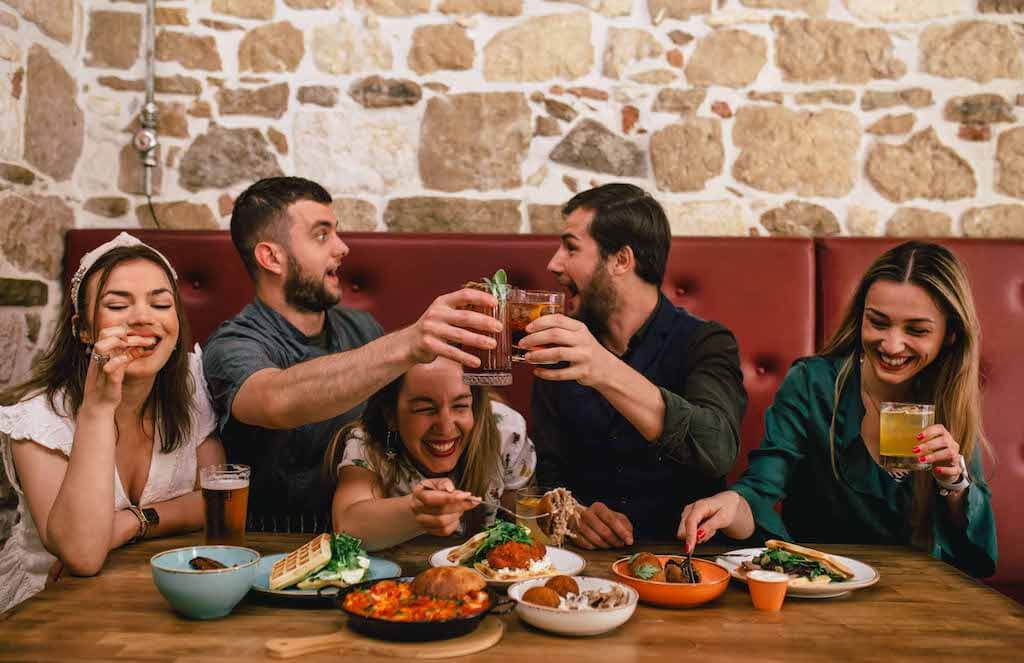
A big part of staying open in the winter for The Daltonist is that we have developed an amazing team, and we are all here long-term. Businesses rely on their people. When you can provide people with stable, year-round work, everything develops much faster. So we thought not about how little we could get away with but instead how much. That revolutionized things for us. And looking at things metaphorically, if you invest more into Split, there will be more tourism.
If you are a business in Split with a winter program, please contact This email address is being protected from spambots. You need JavaScript enabled to view it. with the subject Split Winter Tourism.
After Dubrovnik's Success, Will North America and Split Airport be Connected?
October 20, 2021 - With the success of Delta and United Airlines in Dubrovnik, are flights between North America and Split Airport next?
In the first ten days of October, 80,000 passengers traveled through Split Airport, almost as before the pandemic. This year it holds the title of the busiest airport in Croatia, but with the winter flight schedule, only eight direct flights will survive. So for now, there are no announcements or direct flights from North America, although this is an excellent wish of tourist workers, but also Croats after the recent announcement of visa-free travel.
After a successful first season, United Airlines announced flights between New York and Dubrovnik on May 1, 2022. As a result, the American market has become Croatia's strongest non-European market. They reached 55 percent of overnight stays from the time before the pandemic, statistics say.
"For us in Split-Dalmatia County, it is very interesting, and I can say more, given the completion of the Peljesac Bridge, I believe that it will be easier and more accessible for all American tourists to come to other destinations that are not only related to Dubrovnik," Jože Tomaš, President of the Split County Chamber, points out for HRT.
The announcement that Croatians could travel to the US without visas and the desire for more American guests in Split, Hvar, Trogir has again updated the story of direct flights to Split Resnik, this year's busiest Croatian airport.
"I think it is simply time for both the Croatian National Tourist Board and the Ministry of Tourism to start working on it. Unfortunately, we do not have enough capacity on our own, but we are ready to help and participate in extending the season," said the mayor of Trogir Ante Bilić.
They also want a possible connection with the other side of the Atlantic at the Airport. If there were no pandemic, Split would already be connected to Canada.
"We expect that these facilitations that have occurred around abolishing the visa regime will contribute to the fact that we are next in line to establish such a flight," said the assistant director of Split Airport Pero Bilas.
The Split runway is 600 meters shorter than the Dubrovnik runway, but that is not a problem, said Resnik Airport.
As with other airlines, the problem is the destination itself, which with its facilities generates a desire for flights, and in central Dalmatia, when there is no sun and sea, it isn't easy.
That is why this winter will be just as slow as the previous ones, except during the Christmas holidays. Croats can travel to the United States visa-free, for example, via Venice, which offers very tempting direct flights.
For more on travel in Croatia, follow TCN's dedicated page.
Despite Bad Weather, 120,000 Passengers at Split Airport and Ferry Port this Weekend
August 28, 2021 - While the summer weather has disappeared, albeit temporarily, it has not affected the passengers at Split Airport and Ferry Port this weekend, with an expected 120,000 due to travel through!
Although the weather conditions in recent days have hinted that summer is coming to an end, the figures from Split ports say otherwise, because 120,000 passengers in 190 planes and 16,000 vehicles will pass through them this weekend, reports T.portal.
The head of the Reception and Dispatch Service at Split Airport, Mate Melvan, confirmed there will be a pretty good weekend ahead with 190 planes and 40,000 passengers, although slightly more of them departing than arriving.
"There is more pressure on departures than arrivals, but it is natural for this time of year. We can also confirm that the numbers are still high, the traffic is high intensity. We have already exceeded the figure of 400 thousand in August, which means we are heading towards one million this year. We will have the final results at the end of the month," Melvan added.
80,000 passengers and 16,000 vehicles will pass through the Split Ferry Port over the weekend. There, too, the departure of passengers to Split is more pronounced than earlier this season, which means that they are leaving the island for the mainland, reveals Jelena Ivulić from Jadrolinija.
"Due to the crowds in Supetar, we have had an extra line that sailed at 8:45 am from Split. Therefore, we do not have much pressure from Split, and although passengers still arrive, the truth is at a slower pace. Certainly, the season is not over yet since passengers are still coming," Ivulić said.
It is also interesting to note that by August 15, Jadrolinija had a total of 5.3 million passengers and 1.7 million vehicles on the entire coast, which is 85 percent of the turnover from the pre-pandemic 2019.
For more, make sure to check out our dedicated travel section.
Split Taxi Charges 900 kn from Radisson Blu Hotel to Airport, Tourist in Shock (VIDEO)
August 24, 2021 - One Split taxi charges 900 kuna from the Radisson Blu Hotel to the Split Airport. The shocked passenger filmed the incident, which has now circulated around Croatian media.
Taxi drivers working in the Kaštela and Split airport area were appalled by the actions of an illegal taxi driver who charged tourists 900 kuna to transport them from the Radisson Blu Hotel in Split to Split Airport. Taxi drivers note that the real price should have been around 300 kuna, reports Slobodna Dalmacija.
The passengers realized that it was illegal transportation when the driver did not want to take them to the airport but insisted on dropping them off at a nearby bus stop.
The passenger recorded the incident, and in the video, he emphasized that Split is a wonderful city and that, in his case, the problem is not the money but the incorrect behavior of the driver. Furthermore, he warned guests not to take illegal transportation so as not to find themselves in a similar situation.
The driver noticed that the guest was recording him on his mobile phone and asked him to delete the video, which he did not do, but shared publicly.
After paying the requested amount, the passenger greeted the driver with the words, “Don’t do that.”
You can watch the video (in English) below.
On the bright side, the local community has jumped in to show that this illegal taxi driver is not representative of the genuine hospitality in the region.
One example comes from local tour guide Ives Cikatić, who replied to the tourist in the video posted in the Split Croatia Travel 2021 Facebook group.
"Dear Sir
I am a local tour guide. I have worked in tourism since I was 17, that's 30 years now. I have witnessed all sorts of things and felt gutted for this kind of scam. Absolutely disgusting, disrespecting Croatia by acting like this, embarrassing all of us, working hard to present our beautiful country in the best possible way.
The thing is, even if he is illegal, if he charged 300kn, I could understand, but anything above it is an absolute rip-off, disrespectful and embarrassing. We are all humans trying to survive in these difficult times, while Corona messed up our lives. So I understand if someone is trying to make some money for a living, but this guy has gone way too far. I know he is not the only one.
However, for all the others, use other services like Cammeo taxi. They even have an app, and the price is 190kn. As a local, I use them often. In Zagreb, I have my favorite driver, and I call him the day before to let him know about the rides I will need. Also, there are others like Bolt, Uber, and regular taxis with taxi-meter in their cars.
The Airport Shuttle bus to Split port is I think 35kn, you can take rides mentioned above to dock in Trogir for the Bura Line & offshore boats, public transport from Trogir to Split by sea and enjoy the view and navigation to Split port. Also, use the public bus line number 37 that stops at the main road under the pedestrian Airport bridge www.promet-split.hr there are ways.
I am sorry, Sir, that you had to go through this. If you ever come back to Split, you and your daughter will have a free tour from me as a professional tour guide, and I invite you to my home for a typical local dinner with my family and friends. Feel free to contact me anytime.
Thank you for speaking well about our country as you will pass it on to others, and thank you for referring to the things that aren't good so we can improve. That is what matters and is most appreciated.
Thank you for visiting Croatia, especially my hometown, Split, and once again, please take my sincerest apologies for the inconvenience you had to go through.
Kindly,
Ives Cikatić"
For more, make sure to check out our dedicated travel section.


